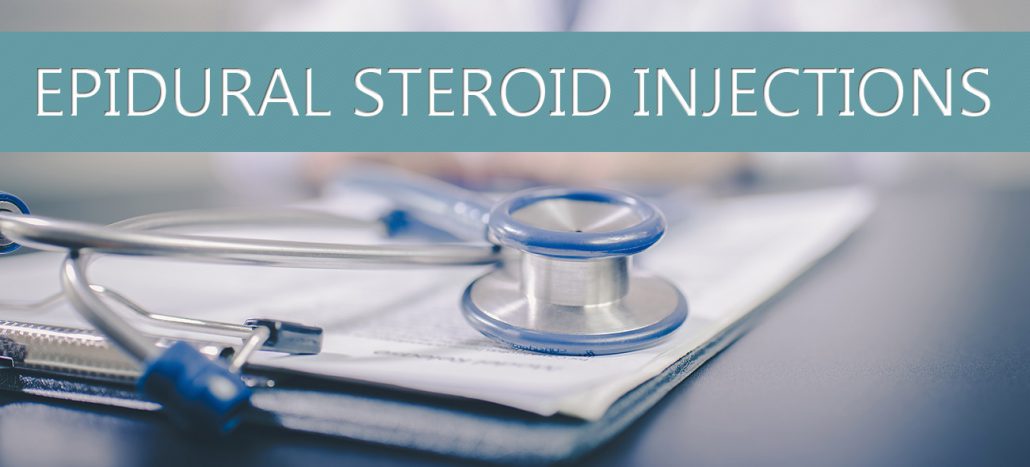Epidural Steroid Injections
Description
An epidural steroid injection is an injection of local anesthetic and steroid deposited into the epidural space. The epidural space is a space located in the spine just outside of the sac containing spinal fluid. The goal of an epidural steroid injection is to provide pain relief by reducing the inflammation (swelling) of the nerve roots as they exit the spine. An epidural steroid injection will not correct the preexisting medical problem (i.e. spinal stenosis, herniated or bulging disc, arthritis, etc.) but may improve the level of pain. It is not unusual for someone to need more that one injection to get long-term benefit. The injections may be done in a series of three injections about 3 weeks apart if needed. If the pain is significantly improved no further injection is needed unless the pain begins to come back.
Note: The procedure cannot be performed if you have an active infection, flu, cold, fever, very high blood pressure or if you are on blood thinners. Please make your doctor aware of any of these conditions. This is for your safety!
Risks of the procedure
The main risk that occurs at a rate of approximately 1/100 is the risk of a dural puncture. (This rate is higher in patients who have had previous back surgery). A dural puncture occurs when the needle is unintentionally advanced one layer beyond the epidural space and punctures the membrane that surrounds spinal fluid. If this occurs there is a risk of developing a spinal headache, which may be severe and may last for days. There is a procedure (epidural blood patch) that can treat the headache if it occurs and does not improve sufficiently in 48 hours. Other risks are remote but include bleeding, infection, nerve injury and allergic reaction to the medication. Some short-term side effects may occur. If local anesthetic spreads to nearby nerves you may have weakness or numbness that can last for 4 -12 hours. If this happens you will have to stay in the Ambulatory Surgery Center until this resolves. You may have increased pain for a few days after the injection. Diabetics may have short-term elevation of blood sugars. People prone to fluid retention may have increased fluid retention for 1 –2 weeks. Most people say the stinging/burning of the numbing medicine is the most uncomfortable part of the procedure though every person’s response to any procedure is individual.
The procedure
After signing a consent form, checking your vital signs and starting an IV, if applicable the procedure may be done in the sitting position or with lying on your abdomen in the fluoroscopy room. The back or neck is then cleansed with an antiseptic soap. A sterile drape is placed. The skin is anesthetized (numbed) with a local anesthetic. This is felt as a stinging or burning sensation. Pressure is the usual sensation felt – if pain is felt, more local anesthetic will be used. Using x-ray guidance, the needle is advanced to the proper location. A dye may be injected at this point (Please let the doctor know if you have an allergies to dye). Once in the epidural space, local anesthetic and steroid are then injected through the needle and the needle is removed, the medication is injected and the procedure is complete. Your skin will be cleansed and a bandage will be applied if needed. (The bandage can be removed on the next morning). Your vital signs will be checked and you will be discharged to leave with your ride after M.D. authorizes discharge.
After the procedure
Most people don’t feel any different immediately after the injection though the pain may be temporarily improved or worsened. The steroid takes two or three days to start to have an effect in most people and peaks in about two weeks. Therefore, it may be awhile before you feel a change in your pain. Some local tenderness may be experienced for a couple of days after the injection. Using an ice pack three or four times a day will help this. You may take your usual pain medications as well after the injection.
Restrictions
You may not drive for the remainder of the day after your procedure. It is best for an adult to be present to drive you home or to go with you in a taxi or on public transportation. This is for your safety. No heat is to be used in the injected area for the remainder of the day. No tub bath or soaking in water (i.e. pool, jacuzzi, etc.) for the remainder of the day.
Take your medications as usual on the day of the procedure with a sip of water but do not eat for six hours before your procedure. Please follow the above instructions unless told otherwise by your doctor.
Notify your doctor
If you experience severe back pain, new numbness or weakness of your legs, loss of control of your bladder or bowels, or signs of infection in the area of the injection, you should call your doctor right away at: 301-530-7303 or go the nearest emergency room.

